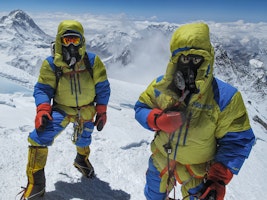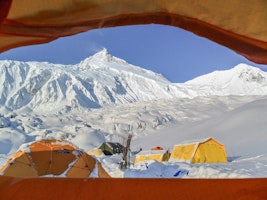Rising to 8.848 meters in elevation – the altitude at which commercial planes fly – Mount Everest is undeniably the ultimate mountaineering challenge.
Lying on the border between Nepal and the autonomous Chinese region of Tibet, intrepid climbers have been trying to climb the world’s tallest mountain for the past 70 years. It is likely to be at the top of every mountaineers’ bucket list, especially those attempting to conquer each of the Seven Summits. However, not everyone who attempts the climb makes it to the top.

There are many reasons why Everest is a difficult mountain to climb. Photo courtesy of Sonam Bhote.
Not everyone who wants to climb the mountain gets the option either. Price and schedule are the biggest limiting factors. Hiring a guide is an expensive undertaking, especially with no guarantee of success. You also must apply for a permit – or risk being arrested if you are caught climbing without one – and there is no guarantee of getting that either.
10 Things You Need to Know about climbing Mount Everest
Below, we’ve provided answers for the top 10 most frequently asked questions about climbing Mount Everest. Among them are important pieces of information any would-be climber should be aware of before planning a trip to the top of the world. Or, explore some other Nepal Treks and Climbs!
1. What are the starting points for climbing Mount Everest? How to get there?
From the Nepalese side, you will begin your Everest climbing adventure from Kathmandu. Most guides will arrange to meet you at the Tribhuvan International Airport (KTM), which offers direct flights from most major Asian international airports and Istanbul.
From the Tibetan side, you will begin your expedition from Lhasa. Most guides will arrange to meet you at the Lhasa Gonggar Airport (LXA), which offers direct flights from Chinese international airports as well as KTM.
2. How long does it take to climb Everest?
Reaching the summit of Mt Everest will take about 60 days from the Nepalese side. This includes arriving in Kathmandu, transferring to Lukla, hiking to Everest Base Camp, acclimatizing, preparin,g and making the final ascent. This last part generally takes about six days. However, it may take longer if the weather does not cooperate.

The long way up to the Everest summit. Photo courtesy of Sonam Bhote.
From the Tibetan side, climbing Mt Everest should take about 50 days. This includes arriving in Lhasa, transferring to Tibetan Everest Base Camp, acclimatizing, preparin,g and making the final ascent. The final ascent also takes about six days.
3. What are the possible climbing routes to Mount Everest?

Prayer flags decorate many stops on the Nepalese side. Photo courtesy of Sonam Bhote.
The two main routes to the summit of Mount Everest are from the southern face (in Nepal) and the northern face (in Tibet).
Starting from base camp at 5.380 meters above sea level, the route up the southern face is the most direct and steepest route. It is the route that is most commonly taken but is not necessarily the easiest.
From the northern side, you begin the expedition at that base camp, which is 5.180 meters above sea level, and trek across the East Rongbuk Glacier, before beginning the ascent. While the climbing is a bit easier on this side, you do spend more days at higher altitudes.
4. Where to stay while climbing Everest?

Camping in specialized tents on the way up Everest. Photo courtesy of Sonam Bhote.
Regardless of the side from which you choose to climb Mount Everest, you will camp each night in specialized tents that have been set up by the Sherpas prior to your arrival.
On the Tibetan side of the border, you can stay at a hotel in Lhasa prior to driving to the first base camp on the day you begin the climb.
From the Nepalese side, you will stay in various villages as you make the 10-day trek to Everest base camp. Along the way, you may stay in local homes in villages or camp overnight, depending on the arrangements your guide has made.
5. How hard is it to climb Everest? What are the main risks at Everest?

Falling into crevasses is among the leading causes of death on Mount Everest. Photo courtesy of Sonam Bhote.
Climbing Mount Everest is hard. Historically, less than 30 percent of people who attempted to make it to the summit succeeded. Nowadays, this figure has increased to about 50 percent, in part due to restrictions by the Chinese and Nepalese governments on who can climb.
In order to successfully summit Everest, you must be incredibly physically fit; most people spend at least one-year training to climb the mountain. You should also be comfortable on AD-rated climbs with previous experience at high altitudes.
If you are not up to the task of summiting Everest, check out our list of the top treks in the Himalayas!
The biggest risks for climbers on Everest are generally avalanches, heart attacks, exposure during storms, frostbite, and falls. However, statistically speaking, you are more likely to die climbing Mont Blanc or riding a bicycle in London than on Mount Everest.
6. How much experience do you need to climb Everest?

Mastering technical skills and knowing how to handle equipment is essential to climb Everest. Photo courtesy of Sonam Bhote.
Climbers attempting to summit Mount Everest should have previous experience climbing on fixed lines; have previous rock and steep snow climbing experience on exposed terrains, and be familiar with crevasse travel techniques.
It is also helpful to have summited at least one 6.500-meter-high peak before attempting Everest.
However, you do not need to be a grizzled veteran in order to make it to the top. Both the Chinese and Nepalese governments require you to hire a guide in order to the summit and both have put considerable infrastructure (ropes, camps, etc.) on the mountain that is absent from other high-altitude peaks. With that said, Everest is the highest mountain in the world, below we share some possible suggestions to prepare:
Best Training Programs and pre-Everest Climbs
- Ama Dablam 5 Peaks Technical Climbing Course: Over the span of 35 days, you will learn and practice all the mountaineering skills you need to climb high mountains. Plus, you will also climb 5 peaks in the Himalayas (all over 6,000 meters) and visit Everest Base Camp. This will give you some acclimatization and familiarity with the terrain as well.
- Manaslu: At 8163 m, Manaslu is the 5th highest mountain in the world and a Himalaya sibling to Everest. It makes for a great preparation climb that will help get you ready for the extremely high altitude conditions you will be exposed to.
- Seven Summits: The seven summits are the highest mountains of each continent. Often, Everest climbers look to complete these seven unique climbs, and taking on many of these mountains also serves as a great training ground for Everest, which is not the hardest, but the highest mountain on the seven summits list.
7. What are the weather conditions on Mount Everest like?

Storms can form quickly at high altitudes, meaning weather conditions change quickly towards the summit. Photo courtesy of Sonam Bhote.
The best time to climb Mount Everest is in late April and May. This is the window of opportunity when the summit is most hospitable for humans. It is after the brutal winter and before the monsoon season.
Climbing from the Tibetan side generally means better weather conditions than from the Nepalese side. Regardless of which side you climb from, weather can change quickly. In a matter of minutes, clear days can turn into blizzards.
Toward the summit, expect temperatures of -10 °C to -25 °C, excluding wind chill. Even outside of monsoon season, wind speeds can reach 250 kilometers per hour.
8. What equipment do you need to climb Mount Everest?

The top can be quite windy, with recorded speeds of more than 250 kilometers per hour. Photo courtesy of Sonam Bhote.
There is a long list of equipment required for any climb up Mount Everest. Always ask your guide for a complete list of what he or she requires you to bring. Some of the following may be included in the price of your trip or available to rent in Nepal or Tibet:
- Ice axes
- Crampons
- Carabiner system
- Alpine climbing harness
- Belay device
- Trekking poles
- Ascender
- Climbing helmet
- Sun hat, knit cap, and buff
- Ski goggles, face mask and nose guard
- Headlamp
- -40 down sleeping bag, inflatable sleeping pad, foam pad
- 32 to 40-lite, 55-liter backpack, two duffel bags, and toiletries bag
- Water purification kit
- Sunscreen
- Running shoes, high-altitude boots, hiking boots, insulated booties
- Appropriate clothing for 60-day mountaineering trip with temperatures ranging from 30 °C to -30 °C
9. Is possible to climb Mount Everest without oxygen?

Most Everest climbs require the use of oxygen. Photo courtesy of Sonam Bhote.
While it is possible to climb Mount Everest without oxygen, it is highly inadvisable.
Only five percent of the people who have successfully climbed the mountain did so without oxygen. Only 10 percent of people who have ever tried to climb Everest without oxygen have succeeded. More than a dozen people have died from health complications relating to a lack of oxygen while climbing the world’s tallest mountain.
Many professional mountaineers who have climbed other 8.000 meter high peaks without oxygen have tried to repeat the feat on Everest and failed, sometimes more than once.
10. How much does it cost to climb Everest?

There are many costs to consider before embarking on an Everest expedition. Photo courtesy of Sonam Bhote.
Expect to spend at least $30.000 (USD) per person when heading out for a Mount Everest climbing expedition. However, depending on the guide and what’s included, trips may cost up to $45.000 or more.
The permit to climb, Mount Everest, alone, is $11.000. Hiring Sherpas to carry the gear will come to about another $8.000. Add on the guide’s fee as well as oxygen bottles ($1.000 each), food, equipment, insurance, and accommodation and you will fall somewhere within this ballpark figure.
Do you have what it takes to make it to the top of the world? Check out all the options available at Explore-Share for a guided mountaineering expedition to the summit of Mount Everest.







